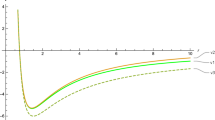Abstract
We compute the bound states for a special type of singular central potential that generalizes the hyperbolic Eckart potential by adding a cubic singular term at the origin while keeping the short range exponential decay far away from the origin. Such strong singular potentials are of practical importance in atomic, nuclear and molecular physics. To bring the solution of the Schrodinger equation for finite angular momentum to analytical treatment we use an analytical approximation to the centrifugal orbital part of the potential that has a similar structure to the Eckart potential. We compute the energy spectrum associated with this potential using both the tridiagonal representation approach (TRA) and the asymptotic iteration method (AIM) and make a comparative analysis of these results.


Similar content being viewed by others
References
P.M. Morse, Phys. Rev. 34(1), 57 (1929)
S.H. Dong, R. Lemus, A. Frank, Int. J. Quant. Phys. 86(5), 433–439 (2002)
S.M. Ikhdair, Chem. Phys. 361(1–2), 9–17 (2009)
J.Y. Liu, G.D. Zhang, C.S. Jia, Phys. Lett. A 377(21–22), 1444–1447 (2013)
B.J. Falaye, S.M. Ikhdair, M. Hamzavi, J. Math. Chem. 53(6), 1325–1350 (2015)
L. Infeld, T.D. Hull, Rev. Mod. Phys. 23(1), 21 (1951)
S.H. Dong, Factorization Method in Quantum Mechanics, Vol. 150 of Fundamental Theories of Physics (Springer, Dordrecht, 2007)
H. Ciftci, R.L. Hall, N. Saad, J. Phys. A: Math. Gen. 36(47), 11807 (2003)
A.F. Nikiforov, V.B. Uvarov, Special Functions of Mathematical Physics, vol. 205 (Birkhuser, Basel, 1988)
C. Berkdemir, Application of the Nikiforov-Uvarov method in quantum mechanics, 225, Theor. Conc. Quant. Mech. (2012)
A.D. Alhaidari, J. Math. Phys. 58(7), 072104 (2017). and references therein
S.H. Dong, R. Lemus, A. Frank, Intern. J. Quan. Chem. 86(5), 433–439 (2002)
F. Cooper, A. Khare, U. Sukhatme, Supersymmetry in Quantum Mechanics (World Scientific, Singapore, 2004)
M. Bander, C. Itzykson, Rev. Mod. Phys. 38(2), 330 (1968)
Y. Alhassid, F. Iachello, F. Gursey, Chem. Phys. Lett. 99(1), 27–30 (1983)
Y. Alhassid, F. Gursey, F. Iachello, Phys. Rev. Lett. 50(12), 873 (1983)
A.D. Alhaidari, H. Bahlouli, M.S. Abdelmonem, J. Phys. A: Math. Theor. 41(3), 032001 (2008)
I.A. Assi, A.J. Sous, Euro. Phys. J. Plus 133(5), 175 (2018)
I.A. Assi, A.J. Sous, H. Bahlouli, Mod. Phys. Lett. A 33(22), 1850128 (2018)
W.C. Qiang, S.H. Dong, Phys. Lett. A 372(27–28), 4789–4792 (2008)
W.C. Qiang, S.H. Dong, Phys. Lett. A. 368(1–2), 13–17 (2007)
S.H. Dong et al., J. Phys A: Math. Theor. 40(34), 10535 (2007)
S. Dong, S.G. Miranda, F.M. Eriquez, S.H. Dong, Mod. Phys. Lett. B 22(07), 483 (2008)
S. Dong, J.G. Ravelo, S.H. Dong, Phys. Scr. 76(4), 393 (2007)
M.P. Valderrama, E.R. Arriola, Phys. Rev. C 72(5), 054002 (2005)
M.P. Valderrama, E.R. Arriola, Phys. Rev. C 70(4), 044006 (2004)
D. Odell, A. Deltuva, J. Bonilla, L. Platter, Phys. Rev. C 100(5), 054001 (2019)
T.O. Mller, Phys. Rev. Lett. 110(26), 260401 (2013)
W.B. Brown, R.E. Roberts, J. Chem. Phys. 46(5), 2006–2007 (1967)
A.D. Alhaidari, H. Bahlouli, Phys. Rev. Lett. 100(11), 110401 (2008). and references therein
A.D. Alhaidari, Mod. Phys. Lett. A 34(28), 1950223 (2019)
A. Khare, U.P. Sukhatme, J. Phys. A: Math. Gen. 21(9), L501 (1988)
R.L. Greene, C. Aldrich, Phys. Rev. A 14(6), 2363 (1976)
M. Ismail, N. Saad, J. Math. Phys. 61(3), 033501 (2020)
I.A. Assi, A.J. Sous, A.N. Ikot, Euro. Phys. J. Plus 132(12), 525 (2017)
S.A. Al-Buradah, H. Bahlouli, A.D. Alhaidari, J. Math. Phys. 58(8), 083501 (2017)
A.J. Sous, Pramana 93(2), 22 (2019)
A.D. Alhaidari, E.J. Heller, H.A. Yamani, M.S. Abdelmonem, The J-matrix method. Development and Applications (Springer, Berlin, 2008)
A.D. Alhaidari, Ann. Phys. 317(1), 152–174 (2005)
A.D. Alhaidari, Rep. Math. Phys. 84(3), 393–405 (2019)
W. Van Assche, SIGMA. Symm., Integ. Geom.: Meth. App. 15, 005 (2019)
A.D. Alhaidari, M.E.H. Ismail, J. Math. Phys. 56(7), 072107 (2015)
A.D. Alhaidari, T.J. Taiwo, J. Math. Phys. 58(2), 022101 (2017)
M.A. Prasad, R.F. Wallis, R. Herman, Solid State Commun. 77(12), 973–976 (1991)
V.I. Pupyshev, A.Y. Ermilov, Int. J. Quantum Chem. 96(3), 185–192 (2004)
A. Ferron, P. Serra, S. Kais, J. Chem. Phys. 120(18), 8412–8419 (2004)
W.R. Garrett, J. Chem. Phys. 128(19), 194309 (2008)
W.R. Garrett, J. Chem. Phys. 136(5), 054116 (2012)
A.D. Alhaidari, Int. J. Mod. Phys. A 20(12), 2657–2672 (2005)
Acknowledgements
HB acknowledge the support of King Fahd University of Petroleum and Minerals under research group project RG181001.
Author information
Authors and Affiliations
Corresponding author
Appendix A. Relevant matrices for the TRA
Appendix A. Relevant matrices for the TRA
In Eq. 15, few matrices have been introduced. First, the matrix X is defined as follows [31, 49]
where
and
Next, the matrix \(\sigma ^{\pm }\) are define by [31]
where \(\varLambda \) is a matrix containing the eigenvectors of the truncated version of the matrix X of size \((N+1)\times (N+1)\) and \(D^{\pm }_{nm}=\frac{1}{1\mp x_{n}}\delta _{nm}\) where \(x_{n}\) is the associated eigenvalue of the truncated matrix. Lastly, the matrix \(\omega \) introduced in Eq. 16 is \(\omega =-\varLambda \cdot D^{+}D^{-}\cdot \varLambda ^{T}\), where the symbol “\(\cdot \)” stands for matrix product operation.
Rights and permissions
About this article
Cite this article
Assi, I.A., Sous, A.J. & Bahlouli, H. Treatment of a three-dimensional central potential with cubic singularity. Eur. Phys. J. Plus 136, 47 (2021). https://doi.org/10.1140/epjp/s13360-020-01032-0
Received:
Accepted:
Published:
DOI: https://doi.org/10.1140/epjp/s13360-020-01032-0



